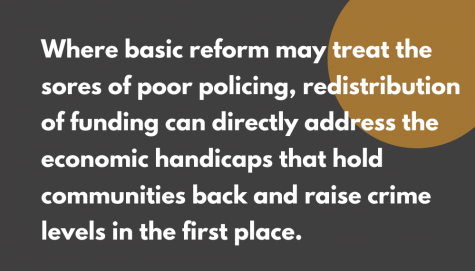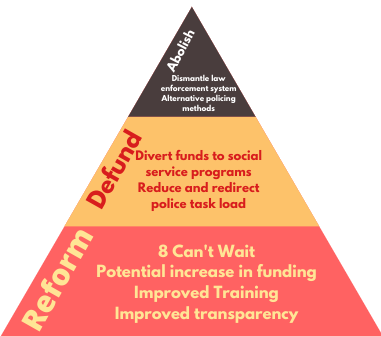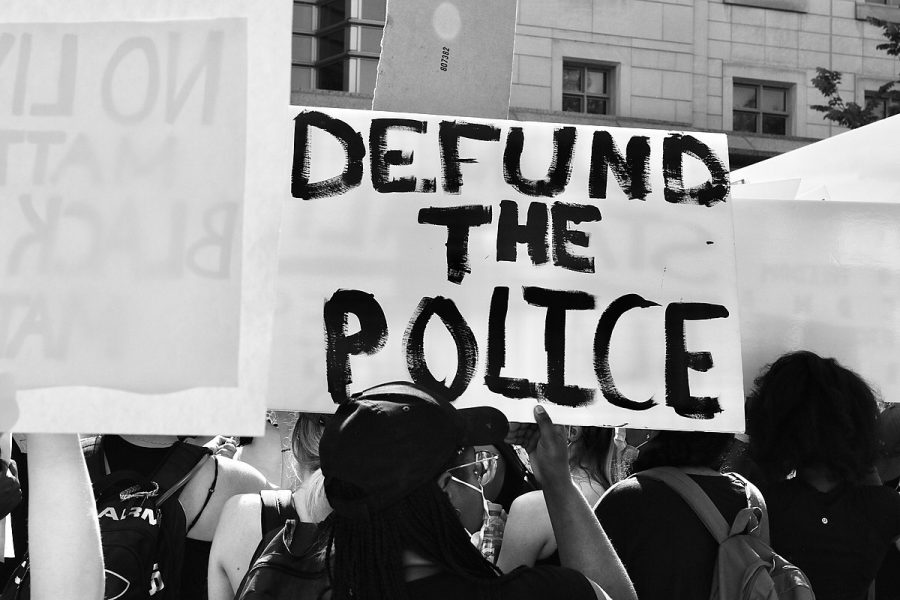Read beyond the Defunding the Police slogan to understand its nuance
Opposing solutions have overlapping answers for fixing a flawed police system
Photo courtesy of Taymaz Valley
A person participating in a BLM protest this year advocates for defunding the police
October 11, 2020
This summer has seen the rebirth of the Black Lives Matter movement against police brutality with even stronger vigor, as protestors around the world took to the streets to challenge the systemic issue of violence — particularly of white officers perpetrating violence on black people within the police system.
Unity has been generally established, with 94% of Americans believing in the necessity of some level of change to the police system. Now is the time for us to reckon with the admitted flaws and offer worthy solutions. Within these solutions, three words have risen up to prominence in the dialogue: reform, defund and abolish. Though these bold slogans are often used and misused by citizens and the media alike, there is complexity in how each solution provides opposing and sometimes overlapping answers to the overarching issue.
Complex solutions are packaged away within neatly phrased repostables, and meaning can often be washed away within these bold statements. In order to move forward, it is essential to understand what each solution actually means and identify the common ground.
Defunding, though mistaken with complete elimination of police funding, is defined by The Brookings Institution as “reallocating or redirecting funding away from the police department to other government agencies funded by the local municipality.”
Defunding acknowledges the limited capacity of police and their inability to handle diverse situations beyond their scope. For instance, circumstances involving mental health patients often lead to ill-fated encounters, which place mentally vulnerable people at high risk for brutality or even death. It also addresses economic inequity issues such as poverty by reallocating the money into community service programs that directly combat these problems. Where basic reform may treat the sores of poor policing, redistribution of funding can directly address the economic handicaps that hold communities back and raise crime levels in the first place.

The phrase “abolish the police” exists in the same realm of shock value as defunding. Americans have consistently shown support for reform but hesitate to reduce the size of law enforcement. Abolition has been compared to defunding like a square to a rectangle: a subsection of the idea of defunding that takes it further and hones in on a more radical resolution. Advocates for abolition also have diversity of thought, from those who use it as a catchphrase to promote greater change to activists who hope to see the actual dismantling of the current law enforcement system. Abolition stems from a history of policing being entirely racial, from its roots in slave patrols and mob lynchings to its continuation into supporting the system of racial segregation and oppression. This continued history to some makes policing in America irredeemable in its current state.
While the differences are continually highlighted, what often goes unsaid in discussions about these solutions is their overlap. The narrative is portrayed as reform being the increasing of funding and defunding being the opposite, when in fact crucial reforms can be made at little cost. A set of proposal ideas called 8 Can’t Wait outline low cost and no cost methods of reducing police violence and introducing reform. The list includes cops holding other cops accountable for excessive force, a ban on choke holds, limiting levels of violence and weapon usage based on the severity of the crime, required warning before use of deadly force, using all methods of de-escalation before considering deadly force, a ban on shooting at moving vehicles and required reporting of force used. These methods have proven effective in cities like Camden, New Jersey, where complaints of excessive force dropped by 95% from 2014 after a series of reforms including a rule requiring officers to intervene to stop other officers from using excessive force. Methods like these are straightforward and crucial within both the ideas of defunding and reforming.
Bay Area cities have had their own reckoning with how to handle calls to defund the police and introduce basic reform. Though many plans remain tentative, cities including San Francisco, Oakland and Berekely have all made open considerations for defunding police budgets with Oakland in particular proposing a fifty percent budget cut with the advisory of its Reimagining Public Safety Task Force. In addition, Senate Bills 773 and 776, introduced by Berkely Senator Nancy Skinner, respectively propose improvements to police accountability with transparency of records and the reassignment of calls involving mental health issues away from police to social service groups.

Despite the great variation within these solutions and what they represent, the increase in discussion signals a greater national dialogue on the issue of police brutality and how to address it. The unity over the issue itself can become a sign of real progress, and may help make this year a turning point rather than a reiteration of the issues that have been present for decades. 8 truly can not wait, and basic reform must be implemented on a large scale in order to raise our standard for police accountability. We must also study the nuances of each solution and the successes and failures of their implementation across the country until this point rather than taking the catchphrases at face value.
FUHSD has had its own share of discussion on the matter of disconnecting police funding and involvement from community environments. An FUHSD board meeting held on September 15 involved debate over the district’s plan to renew its contract with the Santa Clara County Office of Sheriff to assign SROs, or school resource officers, to schools. Members of the Coalition for Racial Justice attended the meeting to request that the board delay its decision, believing that the district should cut ties with the police in order to promote a safer environment for students.
Although fundamental dismantling of law enforcement in the form of abolition may be unfeasible at this point, significant defunding is entirely worth implementing to put more money into treating the root causes of many police encounters and prevent them in the first place. Introducing these changes may allow us to finally challenge our flaws and redeem America from its pained history of policing.

















